


In Nottinghamshire the Waxwing is a scarce to uncommon winter visitor mainly from Finland and north-west Russia. Some years however it ‘irrupts’ and numbers of a few hundred can been seen in the county. The winters of 2000-1 and 2004-5 were two recent years.
W. J. Sterland in his Birds of Sherwood Forest{1869} where he calls it the Bohemian Chatterer, mentions that 1850 was a year of a large influx saying The winter of 1850 was particularly marked by the appearance of several flocks, chiefly during the severe frost in January of that year; many were shot, and all of these had their craws filled with holly berries
. 1871 may also have been an irruptive year as Whitaker says in his "Notes on the Birds of Nottinghamshire{1907}" a good many were seen and several killed at Ossington
. Often these days it feeds on ornamental shrubs and bushes – the types with numerous red and white berries, such as cotoneaster and flowering cherry.
Some years they can stay in Nottinghamshire until early May, giving opportunity to hear their trilling song.
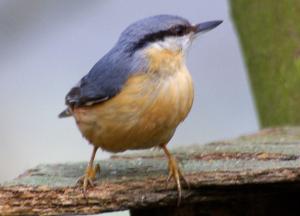
The Nuthatch is probably as common now as in the mid-nineteenth century world of W J Sterland and Joseph Whitaker. It is widely spread in Nottinghamshire – anywhere with trees. They are easily located by their ringing and metallic calls, and by their habit of attacking acorns and other seeds with their dagger bill making a loud hammering noise.
They are unique amongst Nottinghamshire's birds because of their ability to walk down tree trunks as well as up. The Nuthatch is a sedentary bird, not moving far from its birthplace although occasional irruptions happen. In the winter the Nuthatches maintain their summer territory driving away interlopers, usually youngsters from the previous summer. Because they maintain a food cache, keeping their territory is important to them.
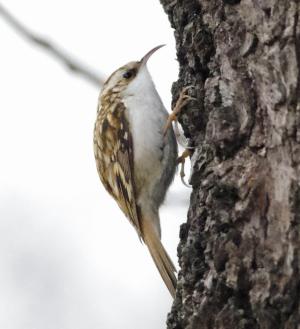
Not as common in Nottinghamshire as the Nuthatch, the Treecreeper is still quite common, but very much overlooked because of its sober colouring and quite ways. The Treecreeper is very arboreal, rarely seen on the ground, likes woodland, both broad-leafed and conifer. It prefers older trees, especially oak and Scots pine which have plenty of crevices in their bark where its long probing bill can search out insects. It also roosts and breeds in these crevices.
Both W J Sterland and Joseph Whitaker considered it a common bird in the late nineteenth century. The Treecreeper population of Nottinghamshire has probably remained constant since then with perhaps a reduction in numbers in cold wet winters, when frozen tree trunks inhibit its feeding.
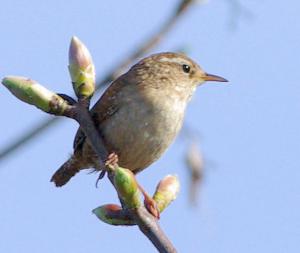
A very common resident in Nottinghamshire, found anywhere there is sufficient cover such as parks, gardens, hedges, even stone walls will provide sufficient for roosting and feeding. W. J Sterland also thought it common in the mid-nineteenth century. Often silent in the winter period, but when March arrives, the song reveals their true numbers.
Hard cold winters are cruel to it and the 1963 winter killed over 90% of the population in Nottinghamshire (The Birds of Nottinghamshire {1975 – Dobbs}). Some Wrens will try and keep their summer territory for the winter, but others – especially those in more exposed areas; will move out , often to reedbeds.
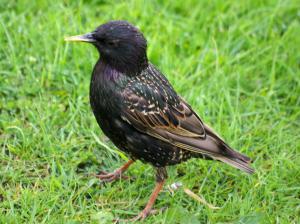
The Starling is a declining, but still common bird in Nottinghamshire. The decline is thought to be caused in part by a reduction in the survival rate of first year birds (Changing demography and population decline in the Common Starling (Freeman et al)).It is ubiquitous in its habitat – woods, parkland, suburbs, farmyards, are all suitable. It breeds communally in cavities, holes in trees or buildings or nestboxes and in the winter roosts in large numbers in conifer woods, reedbeds and on buildings.
In the early 19th century the population of Starlings would have be pretty low in Nottinghamshire (Atlas of Wintering Birds in Britain and Ireland {1986, Lack}), but fifty years on, Sterland in the Descriptive List of the Birds of Nottinghamshire {1879} was able to write "a very common bird, breeding in thousands in the old oaks in Sherwood Forest".
The Starling probably reached its maximum winter population in Nottinghamshire in the 1960s when roosts of several hundreds of thousands were seen in Mansfield and Bingham. But a large roost in the present day would only be in the tens of thousands.The decline could be caused by the reduction in pasture which gives the birds access to earthworms, leatherjackets and other soil insects and grubs.
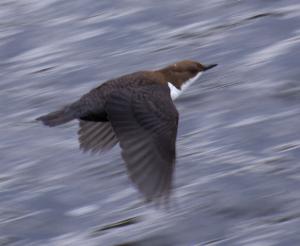
The Dipper is a bird of fast-flowing streams and rivers, and there is practically zero habitat of this sort in Nottinghamshire, so naturally Dippers are very irregular winter visitors to this county, and when they do, it is often to Pleasley in the west they come to. This is on the Derbyshire border which has a good population of breeding pairs.
From what W. J. Sterland and J.Whitaker have to say in their Descriptive List of the Birds of Nottinghamshire {1879} it was an intermittent visitor to Nottinghamshire in the mid-nineteenth century.
Any criticisms, corrections or comments to the author Derek Huskisson

This work is licensed under a Creative Commons Attribution-Noncommercial-Share Alike 2.0 UK: England & Wales License.